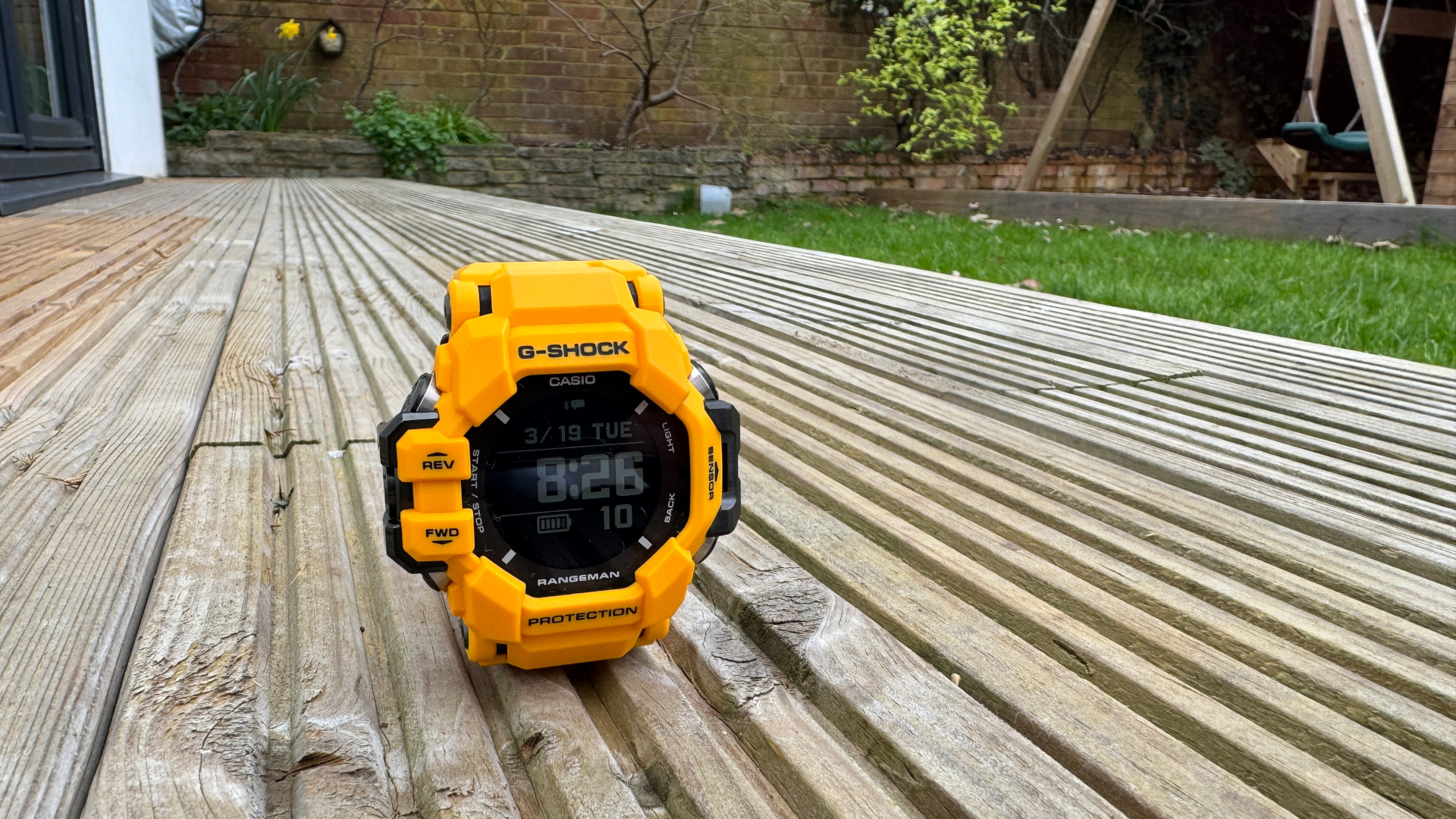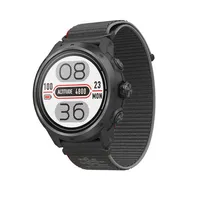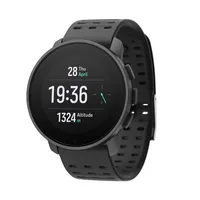TechRadar Verdict
The G-Shock Rangeman is built to look tough and to perform in the harshest of environments. It's crammed with sensors and tracking metrics – including heart rate and GPS – for a wide range of sports including swimming. While it makes a real statement, it could be too chunky for some.
Pros
- +
Stand-out rugged good looks
- +
Physical controls
- +
Great battery performance
- +
Superb tracking smarts
Cons
- -
Limited display quality
- -
Display protection issues
- -
Too chunky for some
Why you can trust TechRadar
Two minute review
The Casio G-Shock Rangeman GPR-H1000 will stand out on any wrist thanks to its bold, angular design – and, in this model's case, punchy yellow finish. This watch screams tough at first glance and Casio is selling on that basis. It might be big enough to get knocked as you wear it, but it's built to take every hit, making it a contender for the best running watches.
It comes with an optical heart rate sensor and full GPS to place it in the running against even the best Garmin watches out there. In fact, this has the Garmin Enduro 2 squarely fixed in its sights, competing on the more extreme tracking with a thermometer, barometer, pressure sensor, altimeter and more onboard. While the Casio tracks well, it doesn't offer maps. This makes it a little limited as a true adventure companion.
However, the Rangeman does pack in solar charging, which will enable you to continue using basic functionality even once the bulk of battery life has been consumed. Although note that with a battery life that lasts up to two months and up to 19 hours in GPS tracking mode, the watch has you covered.
Despite looking chunky, a soft urethane band and double-pin buckle actually mean the Rangeman is comfortable to wear and effortless to find the right fit – presuming your wrist is large enough to pull off this over-sized statement watch.
Editor's note: We've been told, since this review, that the model tested was a prototype. What changes will be made to final version was not clarified.
| Component | G-Shock Rangeman |
|---|---|
| Price | $499.99 / £479.99 / AU$999.99 |
| Dimensions | 53.2 x 60.6 x 20.3 mm |
| Case/bezel | Resin and metal |
| Display | Negative MIP digital display |
| GPS? | GPS |
| Battery life | Two months (19 hours GPS) |
| Connection | Bluetooth |
| Water resistant? | Yes, 20ATM (200 meters) |
G-Shock Rangeman: Price and availability
The G-Shock Rangeman is available now worldwide, priced at $499.99 / £479.99 / AU$999.99.
There are two versions available, the yellow GPR-H1000-9 model reviewed here, and a black variant named the GPR-H1000-1. Other than color differences, they're essentially the same model and share an identical price.
Sign up for breaking news, reviews, opinion, top tech deals, and more.
Since launch, both models have been available on various third-party websites at a reduced price. At time of publishing, the Rangeman can be bought for as low as £375 / $480 / AU$725.
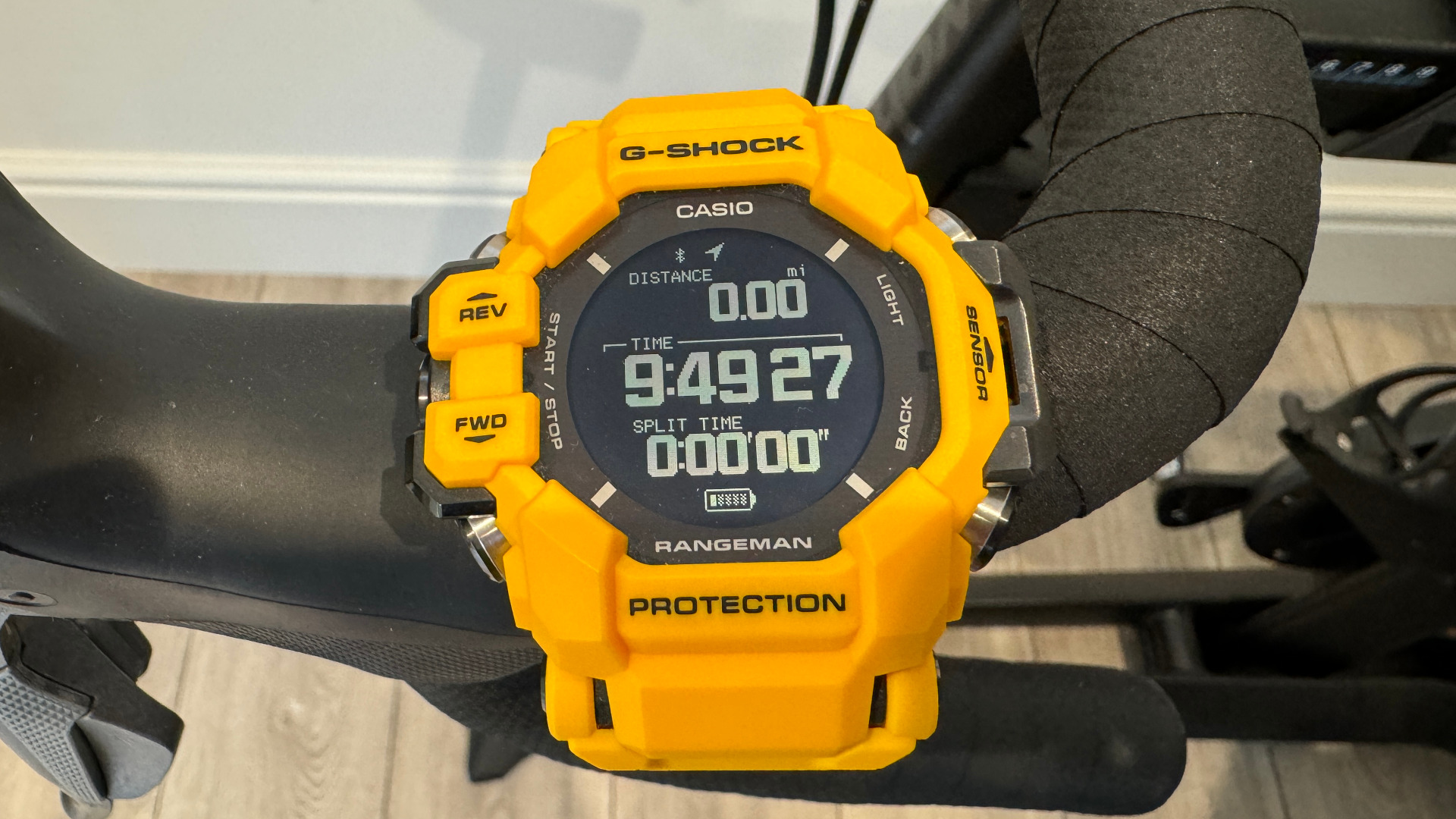
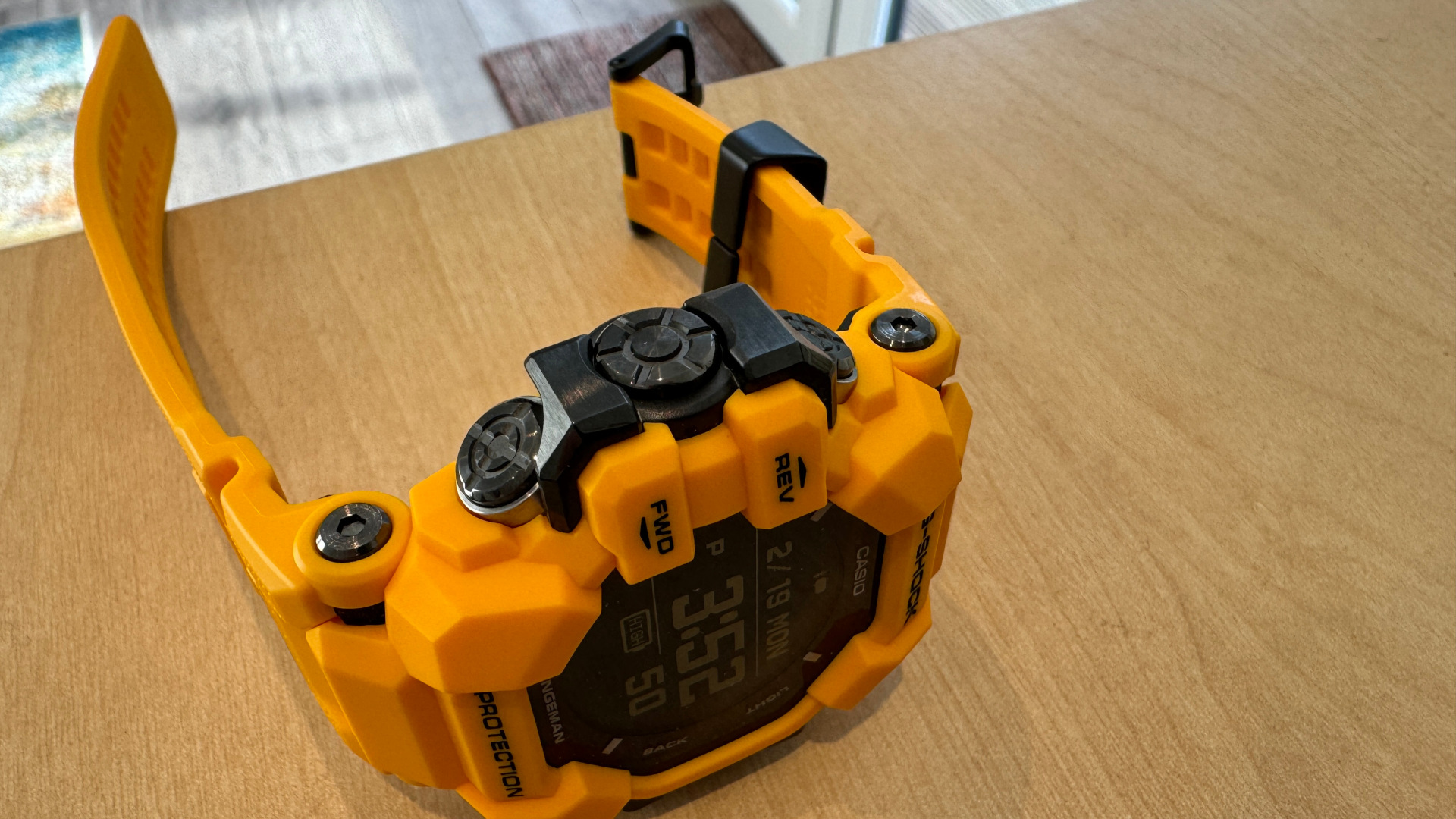
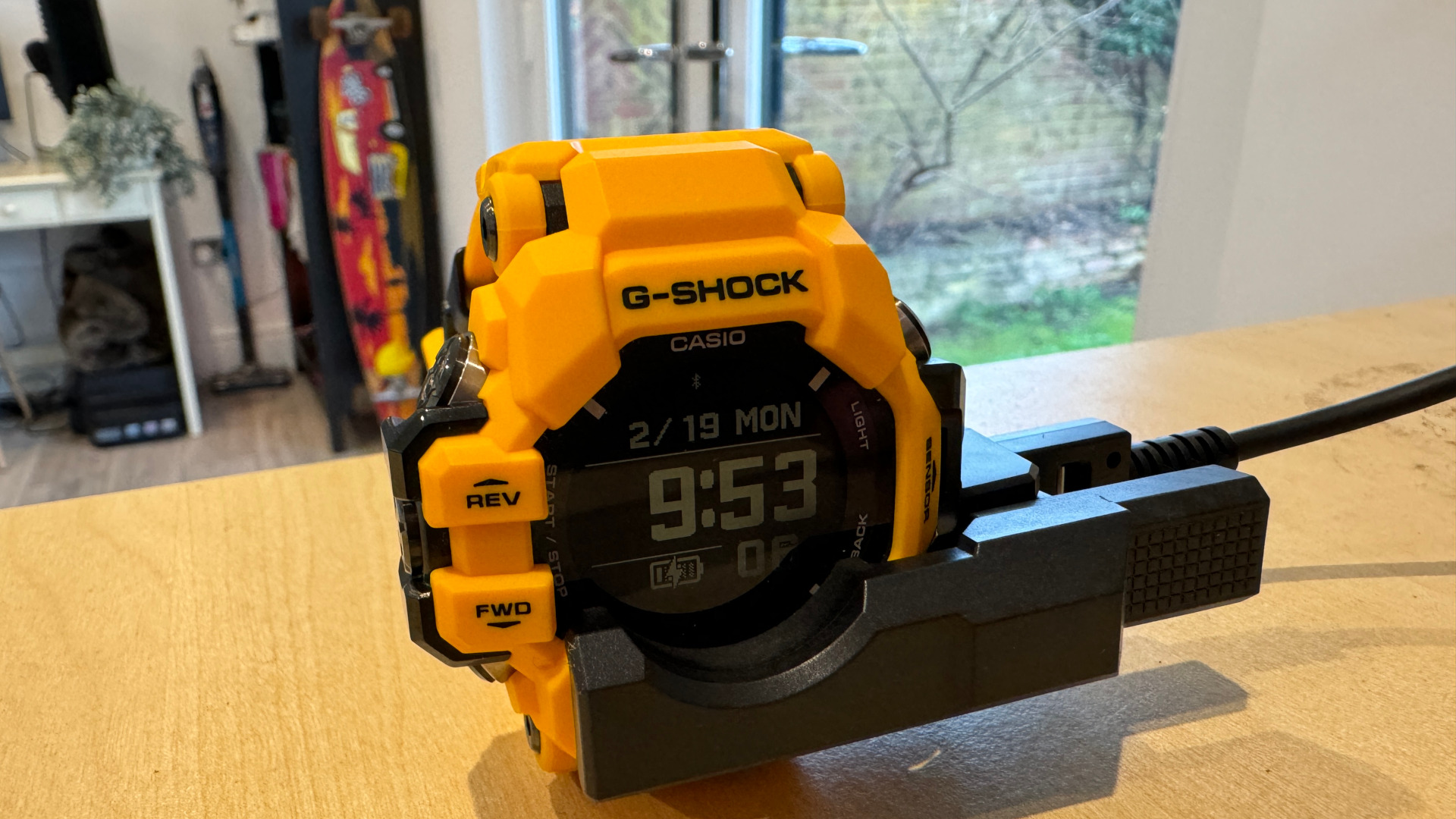
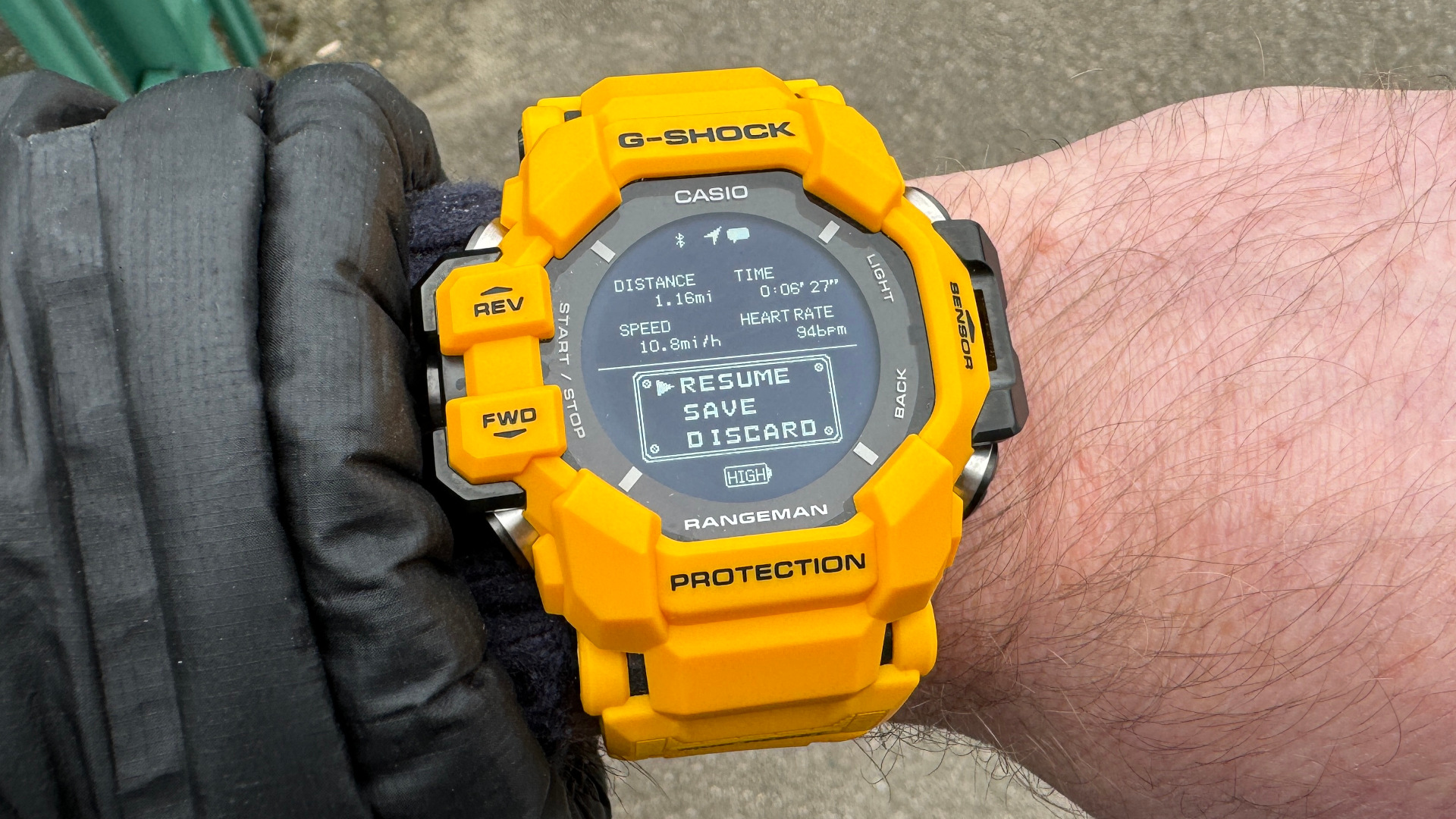


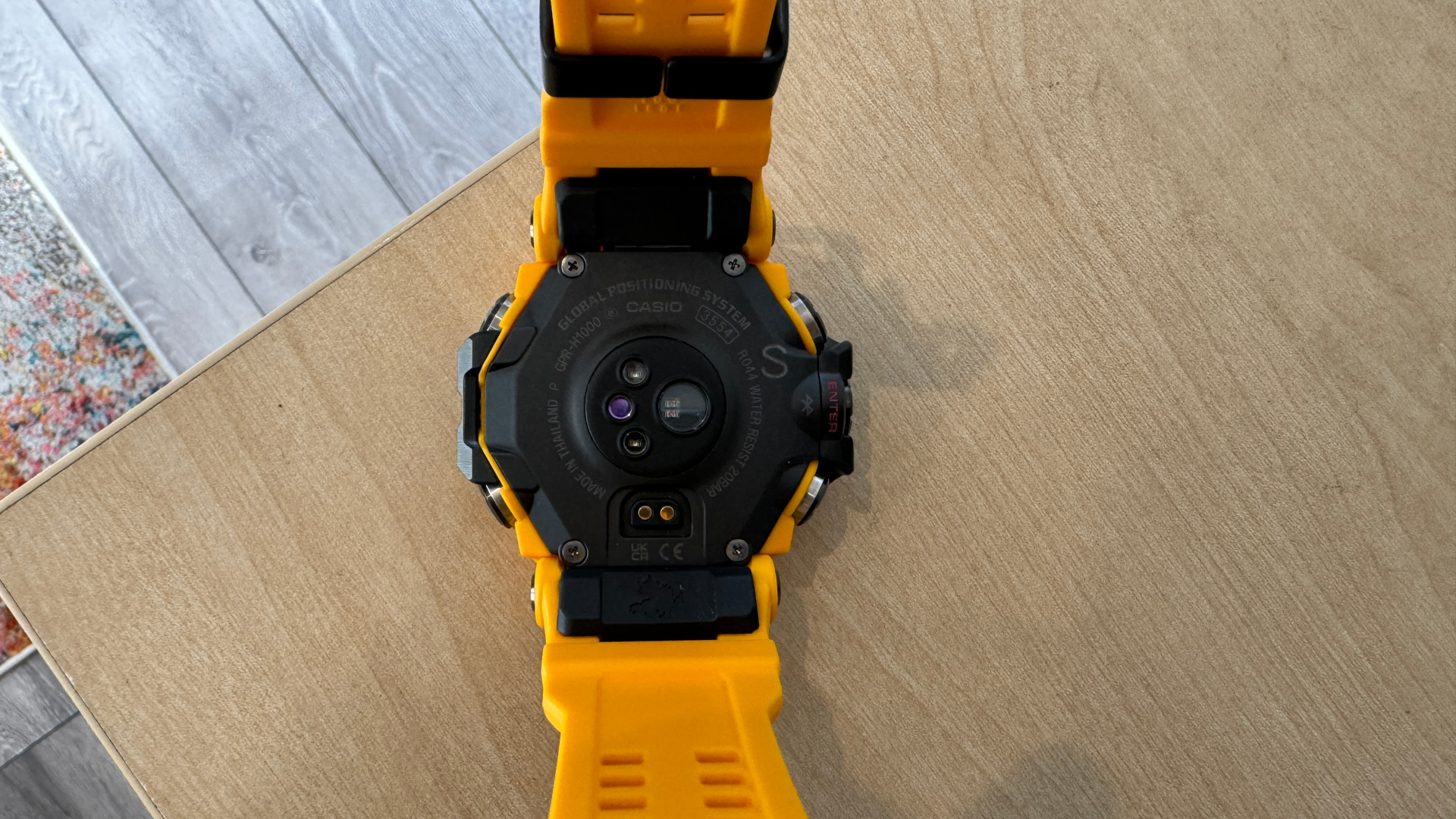
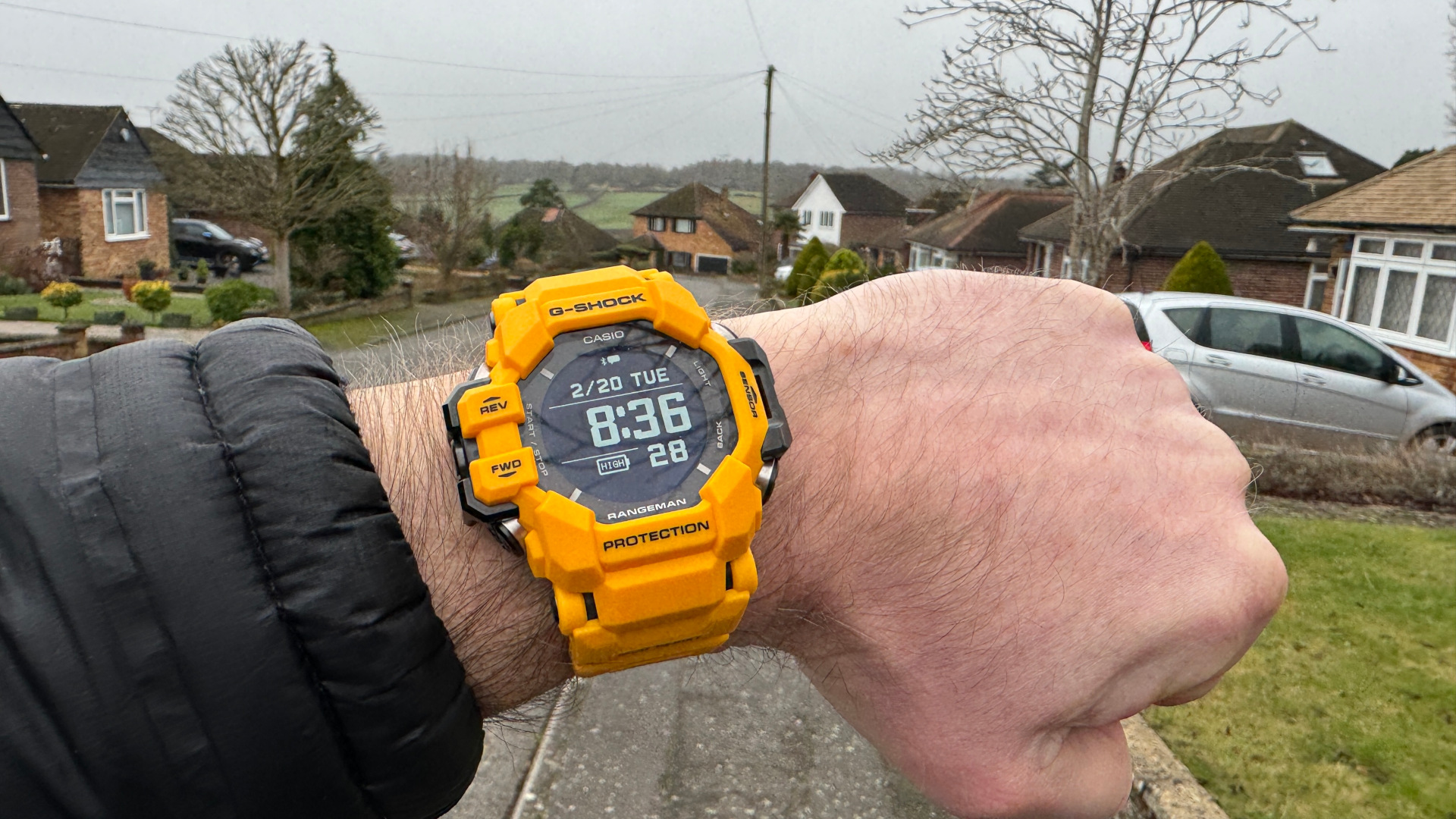
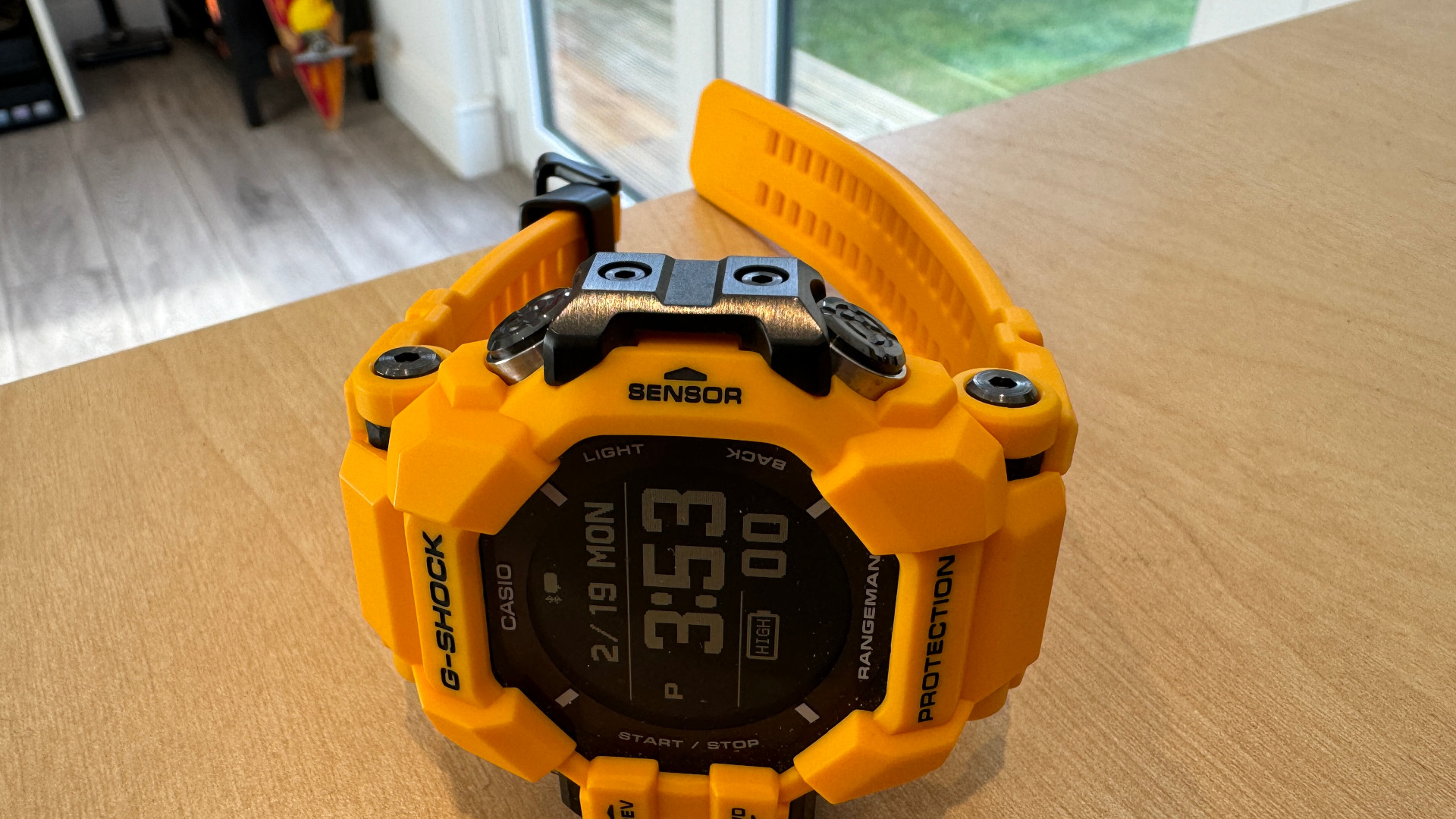

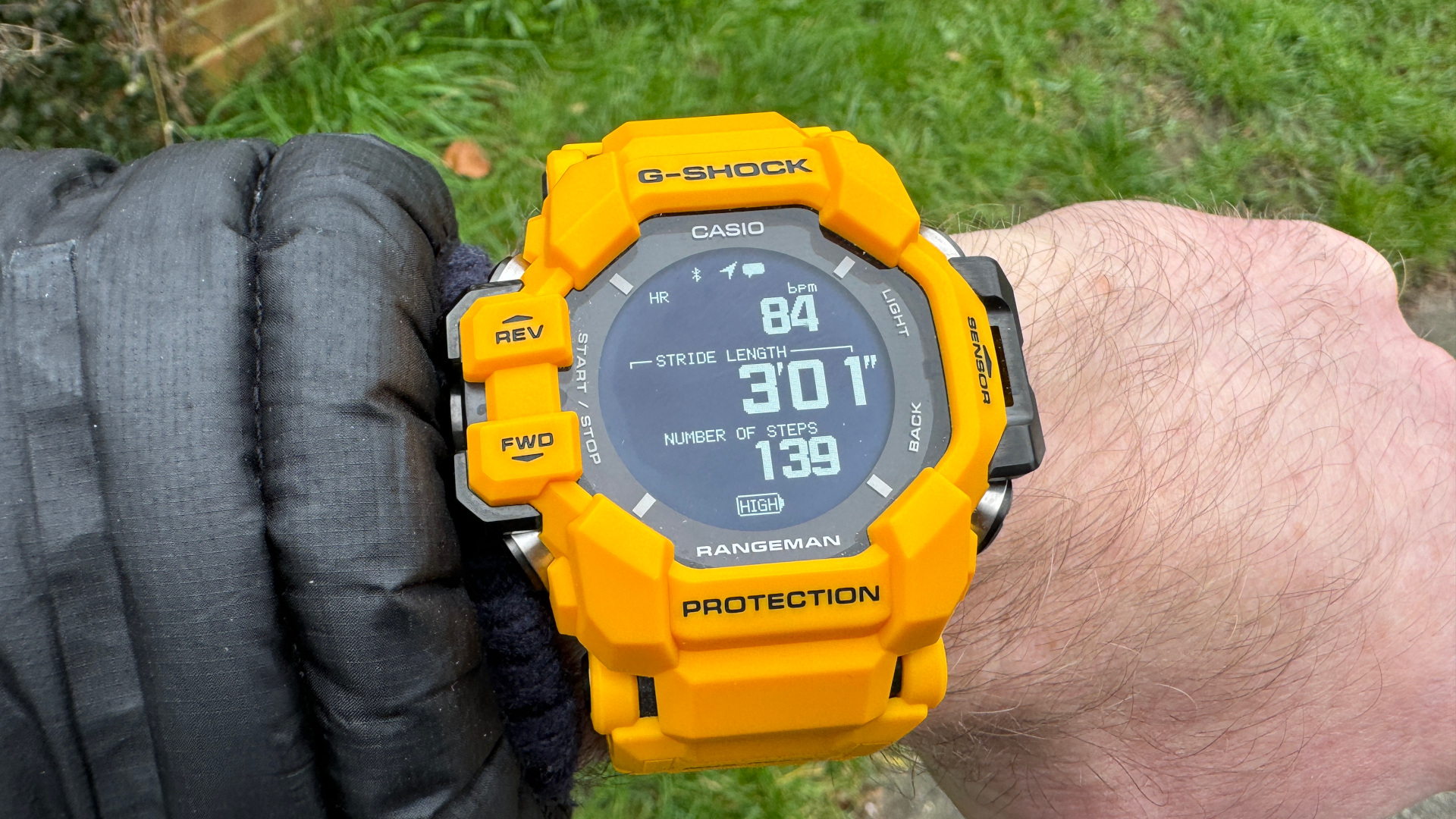

G-Shock Rangeman: Design
- Comfortable strap and accurate clasp
- Rugged exterior
- Too chunky for some
The G-Shock Rangeman is all about that chunky, rugged design and bold looks, which makes it both unique and attractive. But it's worth saying right from the outset that if you have a smaller wrist then this watch might feel a little bulky and heavy. That said, its super comfy strap and very accurate clasp system – plus relatively low weight at 92g – ensure it's as comfortable as a statement watch of this kind can be.
Primarily, this is a button-based beast, so you won't have to suffer touchscreen fingerprints or difficulty controlling screens while taking part in sport or activity. But the flip-side is that you have to scroll through the menus to get to what you want. That said, G-Shock menus are very intuitive, having been developed over many generations of watch, and since the buttons are all mud- and water-protected, they work well. If I have one gripe here it's that the up and down options are on the left, which means you need to use your thumb, rather than fingers, which I found a little awkward or at least took some getting used to.
The display is a negative MIPS, which is a far cry from the color displays on other watches of this kind – and a shock, if you're moving from an AMOLED. That said, it's super clear in daylight, gets you a long battery life, and also offers high contrast so that even underwater it's very clear to read – which was actually helpful when swimming.
The Rangeman has a waterproof rating of 200 metres, yet after a half-hour pool swim the watch's screen appeared to fill with a bubble of some sort that was visible across the screen, and remains still now. The watch works fine, but is now showing this odd line that's definitely worrying. In reality, we'd hope that you could send this back to Casio for a replacement if you suffered the same.
The companion app from Casio is decent and allows you a way to control the watch without all those menus. So if you want to re-order the sports available or setup the data screens, for example, you can do that far more easily through the app, which makes it genuinely helpful. The app is also a better, clearer way to view any data –sleep scores and daily steps metrics, for example.
- Design score: 3.5/5

G-Shock Rangeman: Features
- Tracks many sports
- Offers so many sensors
- Lacks music
The G-Shock Rangeman is absolutely crammed full of features and sensors, delivering the ability to track nine activity types: trekking, running, biking, gym workout, interval timer, pool swimming, open-water swimming, trail running, and walking. And while taking part in an activity, you have access to data such as distance, direction, altitude, climbing speed, time, pace, heart rate, and burned calories.
Swimming offers stroke count, distance and heart rate, as well as a timer with the option to record splits – so all you could want from a swimming watch then. This works both indoors in a pool as well as outdoors for open water swimming, where the GPS can also help with your data readouts. The screen is fantastically clear above and underwater, and I found the stroke count accurate when compared with the Garmin Forerunner 965.
The lack of onboard music, available with most Garmin watches now, was certainly missed here; there's no option to connect headphones and enjoy music during activities. While it isn't a deal breaker, it certainly would have been a welcome feature at this price point.
Solar charging is a great addition here, since it helps to keep the watch function going for pretty much forever. While the GPS and heart rate tracking might leave you out of battery for the sports modes, you'll still have access to the G-Shock time and date basics. The features the watch part offers include a stopwatch, a 60-minute countdown timer, world times, four different alarms, power saving, and a full auto backlight that illuminates for either 1.5 or five seconds, depending on your preference.
While this doesn't pack all the dedicated surf smarts of the G-Shock G-Lide surf watch, you do still get helpful tide data such as 3,300 points for the tide graph. You also have phone notifications – although, on this screen they're a faff to read. I found myself simply using them as an alert before reaching for my phone – helpful, if you want the phone on silent.
- Features score: 4/5

G-Shock Rangeman: Performance
- Accurate GPS and health tracking
- Excellent battery performance
- Quite bulky for daily wear
It soon became clear while testing the G-Shock Rangman that wearing it to bed for sleep tracking was not the most comfortable. I did get used to it, but it was never what I'd call a comfortable experience – but this would apply to all brands of "oversize" watch. During the day, there was no slipping this under a sleeve either. As such, the watch was on show constantly, clearly getting attention with that bright yellow finish.
To be clear, this is a comfy watch, and that strap fits perfectly. It's just chunky, and if you find yourself knocking it on things at first, don't be surprised. This shouldn't worry you, however; that tough exterior appears to be able to handle more than a knock or six. That said, there was an issue with the display on this test unit.
After swimming, it looked like half the screen was filled with water; I pressed down and this moved about under the surface of the screen's top-cover. The watch continues to work just fine, only the screen has this half-filled finish. You can see it in the picture below, where it looks like a trick of the light showing the top third as lighter; but this is water or, perhaps, air inside? Either way, it's disappointing when Casio claims that the G-Shock Rangeman is good for a 200m of diving depth – double that of most Garmins.

In use, the watch performed well. Heart rate was a little on the high side, and quick to jump when compared to a Garmin and chest strap, but this generally levelled out after a while. For cycling, the Rangeman was helpful, where adjustments appeared quickly; but for running , where pure accuracy is ideal, this could have been a little smoother. GPS worked well, with the watch adapting quickly and recording metrics such as speed, pace and distance accurately.
While the menus are dense, the watch is intuitive to navigate, meaning you can access lots of data relatively easily while exercising. It's only really the smaller screen that limits you here, with it often far easier to wait and view the dive data once it had synched.
- Performance score: 3.5/5
G-Shock Rangeman: Battery Life
- Two months standby
- 19 hours with GPS
- Solar powered extras
Casio has certainly used all that chunky G-Shock frame space well when it comes to batteries, since the Rangeman offers up to two months off a single charge. For use just as a watch, that time is extended further thanks to the solar charging smarts, which sees the watch keep going for basics such as time telling.
As you'd expect, it's with GPS use that a smartwatch battery is really tested, and in this regard the Rangeman achieved 19 hours in GPS mode – although that's with intermittent location acquisition. In reality, with it left turned on, battery is nearer to 14 hours. Still, that's plenty for most exercise sessions, while an easy to attach bespoke clip-on charger that uses USB, will bring the Rangeman back to full charge in just a few hours.
One of the great things about this watch is that you can keep using the Rangeman as a watch alone for months, without charging – say , if you're injured and don't need GPS tracking – topping it back up once you're back to activities.
- Battery life score: 4.5/5
G-Shock Rangeman: Buy it if…
You want a statement watch
The G-Shock Rangeman is a handsome watch, standing proud on your wrist for both yourself and others to enjoy. IT certainly makes a statement.
You want solar longevity
Solar charging means you can use the Rangeman in watch-only mode for months without the need to charge.
You enjoy multi-sport
Offering plenty of sports training metrics, the Rangeman is ideal for triathlon training and beyond.
G-Shock Rangeman: Don't buy it if…
You want comfort
On the wrist, this watch is comfy; but it's chunky and takes getting used to – meaning it won't be ideal for everyone.
You want maximum bang for your buck
Spending this same amount will see you able to pick up a watch with music onboard and a better screen, or longer battery life, if those are priorities for you.
You want topographical maps
While this is an outdoorsy watch, it doesn't come with maps, making it less helpful for the true adventurer.
Also consider
| Component | Garmin Instinct Crossover | Coros Apex 2 Pro | Suunto 9 Peak Pro |
|---|---|---|---|
| Price | $499.99 / £479.99 / AU$999.99 | $499 / £499 / AU$850 | $549 / £419 / AU$759 |
| Dimensions | 45 x 45 x 16.2mm | 46.1 x 46.5 x 14mm | 43 x 43 x 10.8mm |
| Case/bezel | Fiber-reinforced polymer/stainless steel | Grade 5 titanium alloy | Reinforced polyamide/stainless steel |
| Display | 176 x 176px, MIP, chemically strengthened glass | 260 x 260px LCD, sapphire glass | 240 x 240px, sapphire crystal |
| GPS? | GPS, GLONASS, Galileo | GPS, GLONASS, Galileo, Beidou, QZSS | GPS, GLONASS, Galileo, QZSS, Beidou |
| Battery life | 28 days (25 hours GPS) | 30 days (45 hours GPS) | 300 hours (30 hours GPS) |
| Connection | Bluetooth, ANT+ | Bluetooth | Bluetooth |
| Water resistant? | Yes, 100m | Yes, 50m | Yes, 100m |
| Maps? | No | Yes, topo | No |
Coros Apex 2 Pro
Competitively priced with good GPS functionality, outstanding battery and topo maps, the Apex 2 Pro is a decent alternative adventuring companion.
Suunto 9 Peak Pro
Suunto's offering is feature-rich, comfortable and offers superb GPS tracking and battery life. If you don't mind a relatively naff display, it's a sturdy, reliable watch.
First reviewed: March 2024
Luke is a freelance writer and editor with over two decades of experience covering tech, science and health. Among many others he writes across Future titles covering health tech, software and apps, VPNs, TV, audio, smart home, antivirus, broadband, smartphones, cars and plenty more. He also likes to climb mountains, swim outside and contort his body into silly positions while breathing as calmly as possible.
